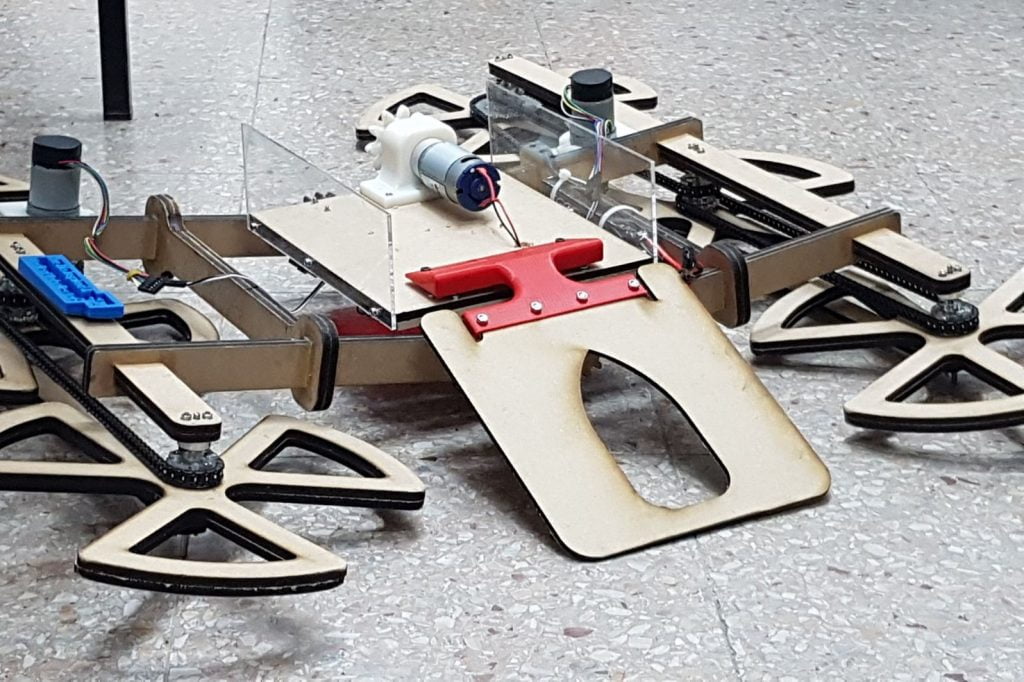Cockroaches may not evoke much more in most people than maybe fear, disgust and a need to make a run for the nearest sturdy shoe, but a group of Israeli researchers at Ben-Gurion University of the Negev were inspired enough by the insect to build a robot designed with its leg and body movements in mind to serve in search and rescue operations.
Named STAR (“Sprawl-Tuned Autonomous Robot”), the robot is one of several being developed at the university’s Bio-Inspired And Medical Robotics Lab led by Dr. David Zarrouk in the Department of Mechanical Engineering. The lab specializes in making robot prototypes with several applications including search and rescue, medical surgeries, space and even agriculture. The robots were showcased as part of a recent press tour of the four-year-old lab, nicknamed “Toys R Us.”
SUBSCRIBE TO OUR WEEKLY NEWSLETTER: SIGN UP HERE FOR FREE
The six-legged robot prototypes all feature similar movements in which the wheels are angled away from the body, to allow it to tackle all types of obstacles. Like cockroaches, the robots can also flatten themselves to slide under narrow openings.
Wow! Check out this robot in action! It's a prototype in the search and rescue field straight out of the Bio-Inspired and Medical Robotics Lab at @bengurionu. pic.twitter.com/LKzojm0mnl
— NoCamels – Israeli Tech and Innovation News (@NoCamels) March 5, 2018
Unlike a cockroach though, if the robots are knocked on their backs they can invert their wheels to keep moving, and can be fitted with a ramp to mount cameras or lighting fixtures. These features can potentially save lives in search and rescue operations in collapsed buildings, Dr. Zarrouk explains.

A STAR robot built by the Bio-Inspired and Medical Robotics Lab at Ben-Gurion University of the Negev. Courtesy
Another robot can climb vertically between two structures, walk horizontally between two walls and features a “turtle gait,” while a third, the RStar, is a smaller version of the STAR and is built for outdoor environments.
Dr. Zarrouk, an award-winning scientist who earned his PhD in Medical Robotics at the Technion, says that all the robots have simple designs and that the lab builds all its own hardware, using some 3D printing. Currently, the research team is “working on building intelligence into the robots” so they can move more autonomously.
The mechanics of the Search & Rescue robots, says Dr. Zarrouk, are patented as the lab looks for partners to take the innovation forward.
Dr. Zarrouk’s lab has also developed an innovative type of robotic arm that could be useful in outer space.
The Minimally Actuated Serial Robot, MASR, operates much like a traditional snake robot with many connected motors, except that it only uses two: one to travel along the structure and another to rotate the joint it needs to flex.
Dr. Zarrouk says the design is ideal for space applications because it is lightweight and could be used for missions like fix malfunctioning satellites, and for docking or refueling to increase satellite lifespan. “This unique minimalistic configuration, which can be applied to any serial robot with two or more links, reduces weight, size, and cost,” he says.
Sign up for our free weekly newsletter
Subscribe“The configuration of the MASR robot combines the best characteristics of existing robot technologies to achieve a high level of accuracy and control,” he says.”In addition, the ability to add or subtract up to four links in less than a minute makes it possible to target quick repairs in isolated sections.”
He adds that the robot is easy to operate and would likely have agriculture applications as well, like picking fruit. The lab is experimenting with adding motors to the robot to increase speed and exploring ways to apply their minimally actuated concept to walking robots.

MASR. Image: Ben-Gurion University of the Negev. Courtesy
In the medical field, Dr. Zarrouk lab has developed three types of robots built for use in surgeries and exams.
Building on the world-renown PillCam, developed by Israeli medical company Given Imaging which pioneered a non-invasive method of detecting disorders in the gastrointestinal (GI) tract, the lab researchers invented a self-propelled camera pill that moves inside the body. The original idea behind the innovation was to have patients ingest a pill-sized camera to allow physicians to visualize the esophagus, colon, and areas of the small intestine.
Dr. Zarrouk says that while the pill takes 6-8 hours to move through the body, the lab’s invention allows the battery-operated pill of 4cm with a speech of 1cm per second, to get to certain areas quicker and stop where physicians deem necessary. In surgeries, he explains, the camera pill can reach specific areas to facilitate incisions, and he envisions that the pill can also be used for targeted drug delivery.
While conceding that up to 40 groups and companies around the world are working on the same concept, Dr. Zarrouk says that none have yet succeeded in making the idea work in hospitals and that he hopes his team will be the first.
Another series of medical robots are the single actuator earthworm and inchworm, each with a single motor that coordinates the motion of the cells and clamps. They can move rather quickly, at 5cm per second, and are designed for movement through blood vessels.
The SAW robot, meanwhile, is a battery-powered device that uses wave-like motion to propel forward, climb and reverse. And it can even swim.
At 57 cm per second, it’s the lab’s fastest robot, and has medical, industrial and search and rescue purposes.
Dr. Zarrouk says he is working with medical doctors to further develop the robots while looking for funding to produce tiny versions of them.
Related posts

Editors’ & Readers’ Choice: 10 Favorite NoCamels Articles

Forward Facing: What Does The Future Hold For Israeli High-Tech?

Impact Innovation: Israeli Startups That Could Shape Our Future




Facebook comments